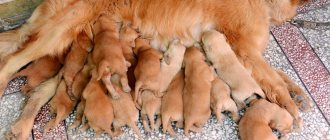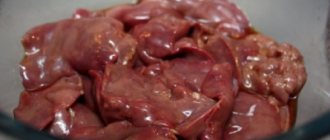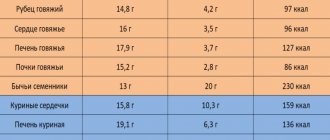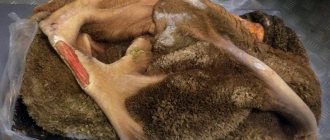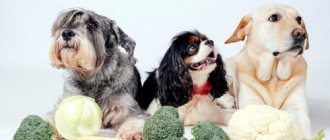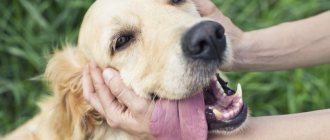Basic nutrition rules for Labradors
A rational approach to feeding a pet is the key to not only good health, but also a long life, its mood and well-being. Literacy in menu planning is needed both in puppyhood and in adulthood. Before moving on to the menu, you need to learn the general rules:
- Take into account the energy needs of your dog, based on them you need to calculate the energy value of the daily diet.
- Use one type of food: either natural or dry food. It is not recommended to mix them.
- Organize your feeding schedule. The animal must get used to the fact that food is given at a certain time, in a specific amount.
- Do not overfeed, this breed is prone to obesity, which leads to serious problems with the body.
- When forming your own diet, check the ratio of BZHU. The list of products must include meat, poultry, fish, cereals, and dairy products.
- Warm up your food, the optimal temperature is room temperature.
- It is better to feed after a walk, then the pet will have a good appetite, and the food will be digested longer and more thoroughly.
- Fresh drink should always be available. The daily fluid intake is 50 g. per 1 kg of weight, that is, a Labrador weighing 40 kg should drink 2 liters. When feeding ready-made dry food, this figure increases.
- Don't give anything from the table, our food is harmful to the animal's stomach. In addition, this makes the dog more capricious and disobedient.
Nutrition should always be based on the condition of the pet; it can be complete, dietary, or for children.
For safe feeding, the dishes from which your pet eats are important. It should be unbreakable, with rounded edges. A metal bowl, glass or enamel plate works well. Do not use plastic, it is toxic and fragile. After each meal, leftover food is put into the refrigerator and the container is washed.
Water in a Labrador's diet
Water is the most important component of a dog's diet. Despite the fact that natural food contains enough moisture, the puppy should not limit access to fresh water. In the case of feeding dry foods, this issue is especially relevant. The bowl must be washed frequently and the water changed. Tap water is suitable for a pet only if the owner is confident in its quality. It is unacceptable to allow your dog to drink from puddles.
The water bowl should be secured: Labradors are notorious for knocking over dishes and sleeping on damp floors.
About baby nutrition
From the first months of life, Labradors are active and explore life with interest. They move a lot, play, and grow quickly, so their diet should be quite rich. On the other hand, you need to focus on an early age, because some foods are still too heavy for a growing body. The size of puppy food is indicated on the packaging. You can calculate the serving size of natural food based on the following table:
| Age (months) | 1 serving (kg) | Feedings per day | Daily value (gr.) |
| Up to 2 | 0,05 | 6 | 0,3 |
| Up to 4 | 0,06-0,08 | 5 | 0,3–0,4 |
| Up to six months | 0,1 | 4 | 0,4 |
| 7-11 months | 0,13 | 3 | 0,4 |
| Older | More than 0.35 | 1-2 | More than 0.7 |
Let's look at the specifics of feeding a Labrador by month with natural food or ready-made pellets. What does the menu consist of?
1 month – start of complementary feeding
A month is a time when the dog is very small and requires special attention. Until a month old, the puppy must feed on breast milk, so at this time the babies are not yet torn away from their mother. If you have a newborn, then it is permissible to feed a 1-month-old Labrador puppy with boiled milk.
Next, you need to start complementary feeding. If the puppy has just been adopted, check with the breeders what kind of food he is used to, so that at first he adheres to its principles.
After a month, it is advisable to continue breastfeeding, while simultaneously complicating the diet. Add:
- Dry food soaked in fermented milk (for example, kefir or biolact). The granules should not contain chicken, it is too aggressive an allergen for this age. (This option is suitable for those who subsequently plan to feed the dog dry food).
- Thin buckwheat or rice porridge.
- Chopped vegetables: carrots, zucchini, celery, pumpkin. Potatoes, peas, and white cabbage are not allowed.
- Cottage cheese.
- Fish or dietary meat (pureeed). Baby food jars work well.
Salt, sugar and other seasonings are completely excluded from the Labrador's diet.
After the second month
At this time, weaning begins. It is desirable that it be gradual. A Labrador puppy at 2 months old should be fed the same diet as before, but the proportion of meat products increases and the amount of milk decreases. Cottage cheese is replaced with finely chopped beef or poultry, fish. You can prepare semi-thick soups. Add 1-2 eggs per week, vegetable oil, herbs.
After each new product, watch your body’s reaction. If an allergy appears or a bowel disorder occurs, it is better to postpone this type of complementary feeding for 1-2 weeks.
Three to six months
The basis of the diet remains the same, but the ratio of products and the type of their preparation changes. The milk fades into the background, leaving only kefir and cottage cheese. For lunch they serve thick soups, add finely chopped meat or poultry, vegetables and herbs. Porridge is now cooked in a light broth.
Gradually accustom the puppy to solid food, he should learn to chew. Slices of fresh vegetables or fruits (for example, carrots and apples) are well suited for this purpose. Fish oil and powdered eggshells are suitable natural mineral supplements.
Diet for Labradors up to 12 months
At this age, active growth of muscle and bone mass begins, the puppy moves a lot, explores the world around him and his own capabilities. He spends a lot of internal resources, so they need to be replenished. Calcium and protein are especially needed. These substances are fully contained in meat; it becomes the basis of the diet. Porridge and soups are cooked with it. After six months, you can add offal to the menu: lungs, heart, liver, etc. It is better if they are beef.
You can give sea fish, the main thing is to thoroughly clean it of bones. Vegetables, fruits and herbs also remain on the menu. Fermented milk products are given 1-2 times a week. At the age of 6 to 12 months, complex vitamin supplements are especially relevant; they will compensate for the deficiency of vitamins and minerals and contribute to the full formation of the skeleton.
If you feed your dog dry food, then choose professional producers. Dry food for a Labrador puppy should have the label “Puppy” or “Junior” on the packaging.
Feeding pregnant and lactating bitches
Pupping in Labrador bitches lasts about 2 months.
For the first half of the pregnancy, feed the pregnant dog unchanged (excess weight will complicate childbirth).
In the second , they increase the amount of meat (up to 1.5 kilograms per day or ~ 10-15% per week), vitamins and microelements (strictly observing the proportions) or simply switch to food for puppy bitches, the composition of which already takes into account the physiological state and needs animal in building material.
If the dog gets what it needs, then whelping and subsequent lactation will have little or no effect on its condition, coat quality and overall health.
If you switch the bitch to puppy food, there is no need to increase the portions or add vitamins and microelements. Feed your dog 6-8 hours after giving birth unless he asks sooner. With milk, a dog gives away 4-7% of its body weight every day. To ensure that the puppies grow up healthy and do not “drink” it, feed the bitch more often than usual (3-5 times) - the same as in the second half of pregnancy.
Remember about fresh water: it is needed for milk production. If the dog's diet is natural, its food should be liquid (thin porridge, meat soup, milk). Do not give potatoes: starch can clog the milk ducts.
A month to a month and a half after giving birth, gradually reduce the number of times the bitch feeds and the amount of water she drinks in order to smoothly complete the lactation period.
How should an adult dog eat?
At the moment when you choose how to feed your mature pet, do not forget about its two features:
- Labrador is a breed with a need for high physical activity, it needs to move a lot, so the food must contain a sufficient amount of calories.
- These dogs tend to be overweight, so they should not be overfed.
These two points, opposite to each other, indicate that the quantity and calorie content of food must be strictly observed. Nutritional standards for an adult dog:
- proteins – 15-20 g/kg weight;
- healthy carbohydrates (cereals, grain products) – 5-6 g/kg body weight;
- fats – 1-2 g/kg.
With full exercise and walks, the animal is fed twice a day, but if the dog moves little, you can switch to one feeding. The diet also depends on the sex of the individual, the weather, the air temperature in the house and outside.
So, in winter, the portion size increases by 15–20%, the animal spends energy on generating heat. During mating, the diet also increases. On the contrary, sterilized dogs have their calorie intake reduced. The amount of food for males should be 15% more than for females.
What to feed a Labrador puppy by month
The best age to buy a puppy is 3 months. But breeders begin to place the cubs when they are 8 weeks old. Find out from the previous owners what they were given, do not change the puppy’s food for 2 weeks. During this time, decide how you will feed the dog: ready-made food or natural food. I recommend that novice dog breeders use ready-made food, since the manufacturer has enriched it with all nutritional components. Dehydrated kibble does not spoil, so it can be left until it is completely eaten until you determine your pet's feeding rate.
Breeders recommend feeding growing young and adult dogs according to the following scheme:
| Animal age, months. | Frequency of feedings per day |
| <2 | 6 |
| >2<4 | 5 |
| >4<6 | 4 |
| >6<12 | 3 |
| >12 | 2 |
The puppy's estimated need for dry food depends on his age and expected live weight as an adult. Consult with the breeder what weight should be achieved at the end of growing.
I have developed a table by which you can calculate the daily amount of dry food.
| Puppy age, months. | Live weight of an adult dog, kg | |||
| 25 | 30 | 35 | 40 | |
| Amount of feed, g | ||||
| 2 months | 210 | 220 | 240 | 260 |
| 3 | 260 | 270 | 310 | 340 |
| 4 | 280 | 310 | 360 | 380 |
| 5 | 290 | 340 | 380 | 410 |
| 6 | 290 | 330 | 380 | 420 |
| 8 | 290 | 320 | 380 | 410 |
| 9 and older | 290 | 320 | 370 | 400 |
The need for dry food increases until the age of five months. After six months, the amount of food is reduced so that the teenager does not gain excess weight. Labradors are considered puppies until they are fifteen months old. I recommend using ready-made super-premium food up to this age. The size of the diet is subject to adjustment. A dog kept outside during the cold season will need 20-30% more food than a dog living in an apartment. After six months of age, monitor the puppy’s fatness according to the attached table.
If your pet scores above 3, limit food intake or increase exercise.
When you calculate the amount of natural food, rely on the data in the dry food requirement table. Croquettes contain 90% dry matter, cereals, fish or meat - 30%, fruits and vegetables even less. Therefore, multiply the table data by 90/30 = 3. If your goal is to raise a dog with a live weight of 30 kg, then give a four-month-old puppy 310 * 3 = 930 g of food per day.
Watch the video:
List of natural products
Homemade food is an excellent and most natural food option. If you still decide to feed your Labrador natural food at home, we will provide you with a list of necessary products. With it you can create a balanced diet:
- Meat. Makes up 30% of the daily diet, lean beef, rabbit, horse meat are suitable, but by-products are added.
- Poultry is given no more than twice a week in the amount of 1/3 of the total daily food.
- Once every 7-10 days, fish is recommended (it is better not to use river fish due to bonyness and a high probability of infection with helminths). Suitable options are hake, pollock, pike perch, whiting, cod.
- Cereals or cereals are given daily. Their choice is wide, they do not cook only pearl barley and oatmeal, they cause stomach upset. Cook the porridge in broth or water, add 1 tbsp. l. vegetable or olive oil.
- Vegetables and herbs – 20% of the daily menu. Carrots, zucchini, pumpkin, celery, dill and parsley work well. For dessert, you can give a few slices of apple.
- Yogurt, kefir, cottage cheese and other fermented milk products are offered daily. It has a positive effect on digestion and is a source of calcium and prebiotics.
- It is useful to give 1-2 egg yolks a week; this product contains useful microelements. The dog’s body does not absorb protein in this form.
Expert opinion
Kuzmenko Olga Olegovna
Information about the expert
Ask a Question
All meat, poultry and fish must be boiled. If you give your animal raw food, then anthelmintics should be used once a month.
Wet food
Wet canned foods occupy a special place in a dog’s diet. They can be combined with dry food or added to natural food. Wet food contains a sufficient amount of proteins, fats and carbohydrates in their optimal ratio. Hypoallergenic food has been developed for pets with allergies.
The best manufacturers of wet canned food are brands such as Hills, Almo Nature, Barking Heads, Advance, Belcando, Eukanuba, Bozita, Acana, etc.
Eukanuba
How to choose dry food for your Labrador?
Pet owners and veterinarians will always be divided into two camps: some for natural products, others for prepared foods. Both will be right, because there are advantages to each type of feeding. However, when choosing dry food, it is important to give preference to professional brands, and also choose a composition that is suitable specifically for your dog (evaluate the breed, age, health, lifestyle).
High-end food has a balanced composition, is almost 100% digestible and excludes waste products found in economy food, dyes and flavor enhancers. To date, several breed lines have been created for Labradors. Reviews from veterinarians praise:
- Royal Canin Labrador Retriever -30 (for adults) and Royal Canin Labrador Junior (for puppies under one year old). 30% of the composition is natural dehydrated meat. Royal Canina is also based on cereals, 13% healthy fats. This line is suitable for pregnant and lactating females.
- Advance Labrador Adult is a food for adult dogs, the main component is chicken fillet, which creates an optimal level of caloric content while maintaining all useful microelements. Taurine and L-carnitine are added to the composition, which help the heart function and support physical condition.
- Eukanuba Breed Specific Labrador Retriever has a completely balanced composition. Feed with calcium, L-carnitine.
Food Proplan for Labradors
It’s difficult to say which dry food for a Labrador is better; it’s important to look at the dog’s individual characteristics. However, Purina Pro Plan was highly praised by specialists and breeders. She does not have a line specifically for Labradors, but other foods are completely suitable for this breed. You can choose from them the one that suits your dog's needs.
- Most often they take Pro Plan Medium. These foods are designed for large pets leading an active lifestyle. The composition is enriched with vitamins, takes care of the condition of the joints.
- If your dog is allergic, choose the Pro Plan Optiderma series. Aggressive allergens, including gluten, are excluded here, and the ratio of Omega-3 and Omega-6 acids is ideal.
- Pro Plan Optidigest is designed for animals with sensitive digestion. Probiotics normalize the microflora of the stomach and stabilize the functioning of the gastrointestinal tract. Lamb meat, which is the basis of the food, is easily digestible.
Any Proplan is a super premium food. Its distinctive feature is a large assortment of feed, dietary nutrition, and the presence of vitamin E in its composition. Moreover, it has a reasonable price.
Ready-made food for large pets
Good dog food contains all the nutrients necessary for animal health. Very often, dog breeders feed their pets industrially produced dry food, because it takes a lot of time to prepare natural food.
You can offer your pet food of premium and super-premium classes, as well as holistic food. Some manufacturers offer special lines for certain breeds. The Royal Canin brand produces food for Labradors - Labrador Retriever Junior for puppies and Labrador Retriever-30 for adults.
What is forbidden to give to dogs of this breed?
As you can see, the diet of dogs is quite varied, however, there is a list of foods that cannot be fed to a Labrador. Among them:
- Legumes, fresh cabbage, cucumbers, and potatoes cause flatulence.
- Sweets and citrus fruits are bad for health and cause allergies. Chocolate destroys tooth enamel and causes watery eyes.
- Pork, lamb, and fatty beef are too difficult to digest.
- Pearl barley and oatmeal, milk provoke diarrhea.
- Bones (especially chicken bones).
- Smoked food destroys liver cells.
- Marinated, spicy, spicy foods harm the stomach, cause heartburn, and “kill” taste buds.
- Bakery products are not digestible and lead to excess weight.
The food must be suitable for dogs, do not feed cat food or human table food.
Prohibited foods in a puppy's diet
Labrador puppies are not given food prepared for family members. It is very important to feed your pet separately, and it is also a mistake to believe that one small piece of food uncharacteristic for a dog “will not make a difference.”
Dogs are not allowed:
- tubular and boiled bones;
- pickles and smoked meats, as well as sausage;
- floury and fatty;
- chocolate;
- exotic fruits and nuts;
- raw river fish;
- sugar;
- raisin;
- mushrooms.
By adopting the principle of “separating tables” from a puppy’s earliest age as a rule, the owner will not be tempted to feed the pet prohibited foods in the future.
Weekly menu for Labrador (natural food)
It is difficult for a new owner to independently create a pet’s menu so that it includes all the necessary components, so we offer an example of a weekly diet for an adult Labrador on a natural basis.
| Day of the week | Morning | Evening |
| Monday | Cottage cheese with sour cream and fresh vegetables | Rice boiled in broth + beef |
| Tuesday | Yolks with vegetables and a piece of cheese, raw beef | Chicken breast with buckwheat, add greens |
| Wednesday | Kefir with herbs | Rice porridge with broth, beef heart + liver |
| Thursday | 2-3 quail eggs, fresh vegetables | Sea fish with buckwheat |
| Friday | Finely chopped vegetables with pieces of raw meat | Rice, chicken fillet, greens |
| Saturday | Bifidok and water porridge with vegetables | Buckwheat porridge in broth, beef by-products: heart, lung, udder |
| Sunday | Porridge with rye bread crackers and herbs, cottage cheese | Raw tripe with boiled buckwheat |
The diet can vary, as can the number of meals. How many times a day to feed your Labrador is up to you, the main thing is to take into account the dog’s physical activity. Supplement the menu with vitamins and mineral complexes, select the correct ratio of fats, proteins and carbohydrates, monitor your pet’s reaction to food and then you will keep his health for many years.
How to change the power plan
Transition your Labrador from one feeding regimen to another gradually, carefully monitoring all the dog’s reactions. The transition from natural food to dry food takes about 7 days, from dry to natural food - 2 weeks, since the pancreas needs time to fully restore its functions.
Do not mix types of food either in a bowl or at time: feed natural in the morning, dry in the evening.
The general translation scheme is as follows:
| Day | Share of natural feed, % |
| 1-7 | 30 |
| 8-10 | 50 |
| 10-14 | 70 |
| from 14 | 100 |
Rating of the best food for puppies
Natural lamb (meat delicacy), 1016105
Products from domestic manufacturers are in high demand. Purchased for those who are sensitive to synthetic additives. Preservatives, artificial colors, and additives are not used in production. Contents are gelled. Made from selected components. The cooking technologies are the most modern. There were no complaints about quality. The texture is delicious. No need to dilute with water. You can take it to the country or on the road. You don't need a can opener to open the lid. Serves as food for babies up to one year old. Iron cans are used as packaging.
The price per jar is 93 rubles.
Natural lamb (meat delicacy), 1016105
Advantages:
- monoprotein formula;
- quality ingredients;
- versatility;
- ease of transportation and opening;
- affordable price.
Flaws:
- not installed.
Premium Puppy Large with chicken (1011066)
Country of origin: the Netherlands. Designed for puppies of large dog breeds. Enriched with minerals and vitamins, it helps the baby grow and develop properly. It is in high demand due to its significant meat content. Belongs to the category of universal. Can be given to pets up to one year old. The storage location should be dark and cool. Excessive humidity should be avoided.
The average cost is 400 rubles per 1 kg.
Premium Puppy Large with chicken (1011066)
Advantages:
- the presence of healthy fatty acids Omega-6 and Omega-3;
- strengthens muscles and bones;
- improves the immune system;
- convenient packaging;
- positive reviews;
- makes teeth healthy.
Flaws:
- not found.
Hill's Science Plan (1037163)
Products are manufactured in the Netherlands. The main ingredients are lamb and rice. Provides the baby with a start in life and allows him to unlock his potential. Can be given to babies up to 1 year old, as well as to nursing and pregnant women. The presence of high-quality protein allows you to build muscle mass. Docosahexaenoic acid promotes proper development of vision and brain. Minerals strengthen teeth and bones. Not suitable for adult dogs.
Retailers are asking 719 rubles for a package of 800 grams.
Hill's Science Plan (1037163)
Advantages:
- ease of storage;
- excellent taste characteristics;
- balanced composition;
- quality ingredients.
Flaws:
- none.
Puppy and Junior Large (3 kg)
Dry food. Available in granules. Consists of 49% animal ingredients (beef, pork, chicken). Completely meets the animal's protein needs and increases vital energy. Meat is used fresh for cooking. The finished product remains in its own meat juice, which improves its digestibility and taste characteristics.
The purchase price is 453 rubles per kg.
Puppy and Junior Large (3 kg)
Advantages:
- absence of harmful components;
- saturation with minerals and vitamins;
- base - fresh meat;
- There are no GMOs in the composition.
Flaws:
- not installed.
Puppy all breeds lamb & salmon (1035777)
Universal food suitable for puppies of all breeds. Made from salmon and lamb, with the addition of goji berries, herbs, fresh fish and alfalfa. The formula is rich in vitamins, proteins and fats. The berries keep your pet’s immune system at its best, improve hematopoiesis, vision, and the condition of the dermis. Thanks to parsley, the possibility of cancer developing in a dog is minimal. Alfalfa has a beneficial effect on the digestive tract, improves metabolism, and renews cells. Produced at Czech production facilities.
Purchase price – 453 rubles per kg.
Puppy all breeds lamb & salmon (1035777)
Advantages:
- improves the general condition of the animal;
- promotes its active development;
- saturation with minerals and other useful components;
- normalization of digestion;
- kidney cleansing.
Flaws:
- not identified.
Pregnant dog
The diet of a pregnant dog should be different from the normal diet.
It should be supplemented with various minerals, acids and vitamins A, E, D, C, B6, B3.
Don't forget about iron. A pregnant dog must eat it.
The best source of iron is beef: beef heart, liver and kidneys.
The diet of a pregnant bitch must include::
- Omega 3 acids . These acids play an important role in the development of the nervous system, vision and brain of the embryo. Their highest content is present in salmon and fish oil. You can also use gelatin capsules with Omega 3.
- Calcium . This mineral is necessary for the development of the teeth and skeleton of the fetus. Calculate calcium at 900 mg per 450 g of food per day. If a pregnant dog eats high-quality food, then its body should have enough of this mineral.
- Folic acid (or vitamin B9) . This vitamin is simply necessary for a pregnant dog. With its help, a number of diseases such as nerve trunk defects, cleft palate and spinal defects are prevented. Large amounts of folic acid are found in pork, liver and poultry. Experts recommend starting to give vitamin B9 before mating (about 2 months) and until birth.
Dietary errors: excess weight
Vigor, activity, thick and shiny coat, ideal skin condition and normal weight - all this can be considered signs that you are feeding your pet correctly with natural foods. Unfortunately, not all owners manage to properly prepare a Labrador’s diet, which leads to a wide variety of health problems for the dog.
Obesity is the most common problem among Labradors. If your dog's weight begins to fall outside the normal range, reconsider the daily feeding schedule and the calorie content of his diet. It is also recommended to increase the duration of active walks, which will help normalize the pet’s weight.
Other signs of an eating disorder include:
- redness of the mucous membranes of the eyes and ears;
- diarrhea or constipation;
- rumbling in the stomach;
- severe hair loss.
If the owner of a Labrador retriever has questions regarding feeding the dog “natural” food, you should consult a veterinarian.
Features of feeding during pregnancy and after childbirth
A pregnant and lactating dog needs high-calorie and nutritious food. It is necessary to give them vitamin and mineral supplements and more meat. It is advisable to add new products:
- fennel;
- brown seaweed;
- kelp;
- red viburnum.
The expectant mother needs to be fed 5-6 times a day in small portions. This diet is followed during pregnancy and for another 2 months after childbirth.
There are industrial lines of food designed specifically for pregnant and lactating women - Royal Canin Maxi Starter, Royal Canin Giant Starter, Bosch Reproduction, Belcando Puppy Gravy, Bozita Robur Mother&Puppy X-Large, etc.
What type of food should I choose?
During the first month of life, the main source of nutrition for puppies is mother's milk. As they grow older, starting from the age of one month, dogs are gradually accustomed to solid food - natural products or ready-made food.
Industrial feeds are made taking into account all the needs of the animal and contain everything necessary for its proper development; they are easy to use and do not require time for preparation. In turn, natural nutrition is varied and does not contain chemical additives, but you must have certain knowledge and experience in order to create a diet correctly.
So, food must contain:
- prebiotics and easily digestible proteins that promote normal stool and proper balance of microflora, since puppies of this breed are prone to intestinal diseases;
- fatty acids necessary to maintain the quality of the coat;
- components that help strengthen joints.
There is no consensus on what food is best for Labrador puppies. Breeders unanimously speak only about the need for a balanced diet that takes into account the breed characteristics of Labradors.
Expert opinion
Tolkachev Andrey Mikhailovich
veterinarian
When the lactation period ends and the time comes to introduce complementary foods, breeders make a choice in favor of natural products or industrial feeds. Both types of nutrition have the right to exist and both have advantages and disadvantages. A natural diet is certainly beneficial for puppies, but at home it is quite problematic to prepare it correctly without disturbing the balance of nutrients and vitamins. Today, the market offers a wide range of industrial feeds produced by domestic or foreign companies, and choosing the right one for your pet is not difficult. The main thing is to purchase products of at least premium class.
Friend and comrade
When buying a dog, it is worth remembering that in the near future it will be a close friend and will be nearby all the time.
Labrador is a very special breed, you can only dream of such a friend.
And great effort should be made to ensure that the dog grows up healthy, beautiful and active.
You need to constantly feed your dog on time, remember to change the water and just treat it well. Then you will have a loyal and reliable friend nearby who will serve you for many more years!
What food to feed Labradors with health problems
The breed has a genetic predisposition to a number of diseases - it cannot be called absolutely healthy. Labradors are voracious dogs - this often leads to obesity; they are prone to allergic reactions to a variety of irritants; joint pathologies, vascular diseases, epilepsy and hyperkeratosis are common.
Let's look at what food is suitable for dogs with health problems:
- Allergy. Treatment and prophylactic brands have been developed for allergy sufferers:
- Bosch Sensitiv – for pets with allergies and a sensitive digestive system;
- Purina Pro Plan Large Athletic Adult canine Sensitive Skin Salmon with Rice dry – for allergies and dermatitis;
- Belcando Junior Lamb & Rice – hypoallergenic for puppies.
- Obesity. Food with a “weight control” formula for the treatment and prevention of obesity:
- Advance Maxi Light Adul – dietary;
- Hill's Prescription Diet Canine Metabolic+mobility with Chicken dry – to improve metabolism;
- Ontario Weight Control Large Turkey & Potatoes – weight control;
- Opti Life (12.5 kg) Degistion Adult Maxi & Medium – dietary;
- Royal Canin Maxi Light Weight Care – if you tend to gain excess weight.
- Joint diseases. For this pathology, products containing chondroprotectors are indicated: glucosamine, chondroitin. Treatment and prophylactic brands:
- Royal Canin Maxi Joint Care – for the prevention of joint diseases;
- Hill's Prescription Diet J/D Canine Mobility dry is a therapeutic formula with glucosamine.
- Digestive problems. Labradors' indiscriminateness in food and the habit of picking up and eating everything that is in bad shape leads to indigestion. Food for gastrointestinal problems:
- Bosch Soft Maxi – with boar and sweet potato (semi-moist formula);
- Barking Heads Tender loving Care – dietary;
- Happy Dog Diet – for gastrointestinal problems.
Description of the breed
The Labrador breed was officially registered in the 19th century in Britain, where it was brought from Canada. The original name was St. John's. Later, a new name took root - Labrador, or Lab for short. Full name: Labrador Retriever. A dog of large size and extraordinary intelligence. Takes 7th place among dogs in terms of intelligence out of 80 applicants. Can be trained perfectly. The original color is black. Later, the chocolate and fawn generations appeared.
The height of an adult at the withers is no more than 57 centimeters. Dogs are distinguished by powerful paws, drooping ears, and a large head. The body is straight, the loin is wide. The well-set, strong neck and “deep” chest are impressive. The front legs are straight, the hind legs are well developed. The tail is short and thick. The eyes are medium in size, hazel or brown in color. The ears are close to the head.
The character is loving, the mood is always good. They show playfulness and calmness towards people; they will never offend or scare people. Training them is a pleasure. They not only quickly learn commands, but also honestly try not to let their owner down. They get along easily with people and animals. Only birds are not liked, as they are considered hunters.
A real family member, with his own mood and habits. Participates in all important events. Needs communication, but never gets boring with his presence. Carefully observes the mood of those present and does not bother them. A dog can easily be taught to open and close doors, turn lights on and off, and fetch things and slippers. Children dote on them, and the dogs reciprocate. You couldn't find a better nurse and friend for kids.
You need to train your animal regularly. Experts recommend not resorting to punishment for disobedience. The dog will not hold a grudge, but his mood will worsen. Good behavior should be praised, gentle words spoken, and goodies given. If your pet has done something wrong, it is enough to strictly say the word “no”. Intonation will tell your pet that something needs to be changed in their behavior.
The pet does not need special care. It is enough to comb the coat once a week, brush the teeth daily and make sure that parasites do not appear in the ears and dirt does not accumulate. You shouldn't bathe every day. Nails are trimmed once every 10–12 days.
A review of reviews shows that the dog has many more positive characteristics than negative ones, but the latter are worth paying special attention to:
- excessive kindness does not allow the Labrador to become an excellent guard;
- the desire to chew something is constantly present;
- lover of water, even dirty rainwater;
- loves to “bask” in garbage, brings dead mice and birds to the owner;
- snores loudly;
- cannot stand loneliness;
- requires a lot of free space (he is cramped in the apartment).
Weekly diet for a dog weighing 10 kg
| Day of the week | Menu |
| Monday | 200 g cottage cheese, 50 ml kefir, 150 g rice, 250 g meat, 100 g herbs, 200 g vegetables, 1 egg |
| Tuesday | 250-300 ml cottage cheese + milk, 150 g buckwheat, 300 g boiled fish, 100 g herbs, 150-200 g vegetables |
| Wednesday | 250 g cottage cheese + kefir, 150 g rice, 250 g meat, 100 g herbs, 200 g vegetables |
| Thursday | 250 g cottage cheese + yogurt, 150 g oatmeal, 250 g meat, 100 g herbs, 150 g vegetables, 1 egg |
| Friday | 200 g cottage cheese + fermented baked milk, 150 g buckwheat, 300 g meat, 100 g herbs, 200 g vegetables |
| Saturday | 250 ml kefir, 150 g oatmeal, 250 g boiled fish, 100 g herbs, 200 g carrots |
| Sunday | 300 g yogurt, 150 g rice, 250 g fish, 100 g herbs, 100 g pumpkin and beets each |
If you refuse to eat: possible reasons
Sometimes dogs refuse to eat. In most cases this is normal, but sometimes it can be a sign of illness. You need to urgently contact a veterinarian if the temperature rises, the animal becomes drowsy and lethargic, diarrhea, vomiting, and bloody discharge appear.
If your dog refuses food, don't force it
Common reasons for refusing to eat:
- binge eating;
- changing your diet or daily routine;
- stress, fear;
- estrus;
- toxicosis of pregnant women;
- other hormonal changes.
When a dog misses its owner during his absence, it loses its appetite. If, while teaching the puppy to solid food, the owner was too impatient and showed aggression towards the pet, he may refuse to eat.
A loving and caring owner knows well what to feed a Labrador. Depending on the pet’s health, a diet is prescribed - either natural food or a dry diet with the addition of wet food. Vitamin and mineral supplements must be mixed with food.
Balanced natural nutrition: do's and don'ts
When choosing a natural diet, you need to remember well which foods are healthy for dogs and which they should not eat.
What do Labradors eat:
- lean meat of chicken, rabbit, turkey, beef, horse meat;
- low-fat sea fish - cod, pollock, pike perch, hake;
- eggs - during the week you can add no more than 1-2 yolks to the porridge;
- vegetables - zucchini, carrots, pumpkin;
- fruits - apples;
- fermented milk products - cottage cheese, kefir, fermented baked milk, yogurt without additives, grated low-fat cheese;
- cereals - wheat, rice, corn, buckwheat;
- greens - parsley, dill, lettuce, celery;
- sea salt - allowed in minute quantities.



